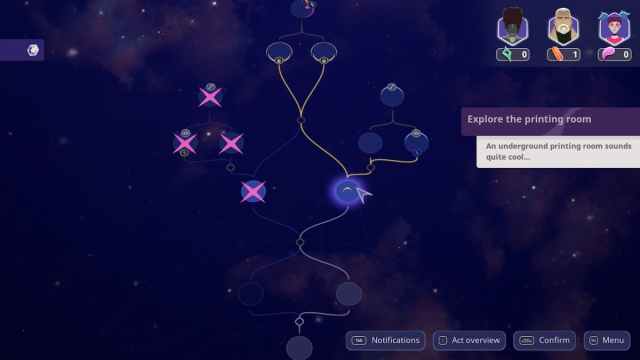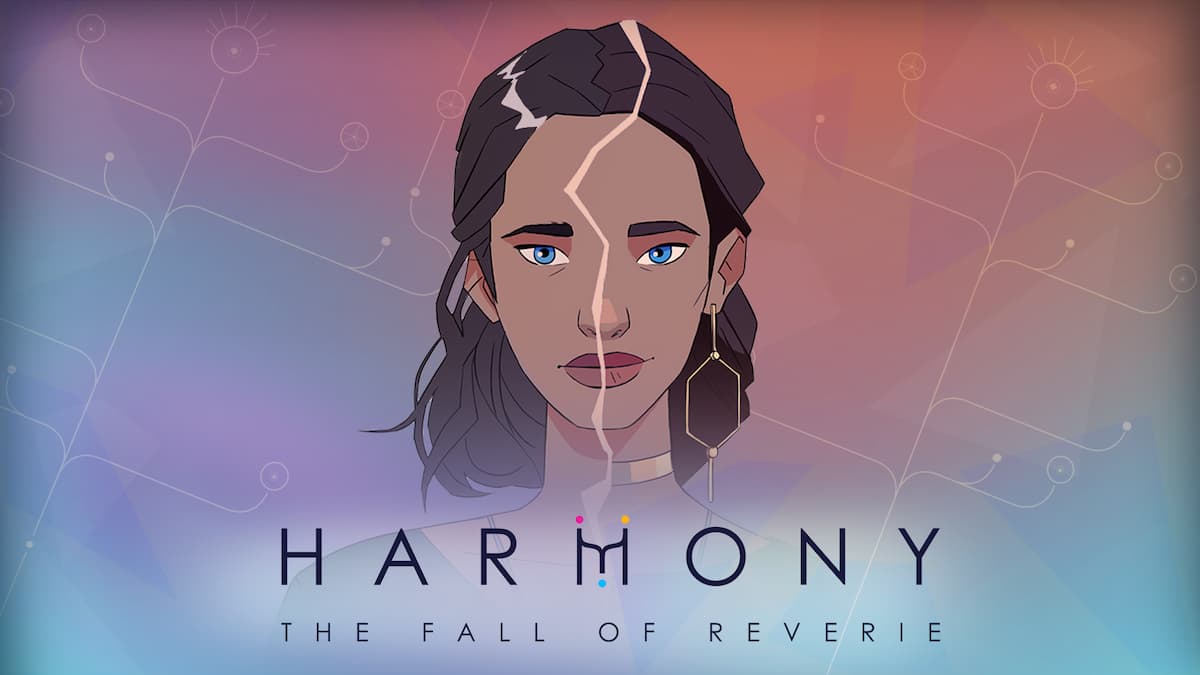Harmony: The Fall of Reverie on PC
During my initial preview of Harmony: The Fall of Reverie, I was already impressed with the complexity of its decision system and the quirky cast of characters. So, now that I’ve completely immersed myself in the official version, things were taken up a notch as the choices become more difficult with each chapter.
If you are an avid decision-based game enthusiast, you’ll undoubtedly have some fun with its unique take on the classic genre. Rather than featuring the traditional good and evil outcomes, you’ll be faced with multiple choices based on your distinct personality type, making the experience different for each player. It also helps with Harmony: The Fall of Reverie’s replay value, where even minor decisions can majorly impact the fate of the universes in the Augural timeline.
At the story’s beginning, players will be introduced to Polly, who has recently returned to her home in Atina after running away from its dreary ways of life in her youth. But, despite her qualms in the past, she must put them aside to unravel the mystery of her missing mother, Ursula, and the corruption of the futuristic MK corporation.
Just as Polly starts her quest to learn the truth about her mother, she discovers a hidden world known as “Reverie” filled with god-like Aspirations: Glory, Bliss, Power, Chaos, Bond, and Truth. They’ll enlist your help with the unbalanced state of the multiverse as Polly transcends into Harmony, a mystical being that bridges the two worlds. Through this newfound power, players must decide the outcomes of both realms, using her clairvoyant abilities to their advantage.

Although the occult talent can come in handy, it does bring in a new set of challenges that will mandate you to strategize instead of mindlessly selecting choices. As a fan of these sorts of games, it was refreshing to see this new take on the genre, where I had to develop elaborate plans to get my desired scenario. Sometimes, it can be overwhelming with the intricate layout of decisions, so those who are beginners may need to familiarize themselves with the gameplay and terminology before progressing further.
Fortunately, there are a ton of resources to refer to, as The Fall of Reverie features an informational Codex that provides details about characters, terms, and settings. However, I do wish there was a general hub for gameplay knowledge since a few words aren’t mentioned in this section, specifically with outcome classifications.
You can still get by with the information you’ll obtain with the Codex, which will constantly be updated as time progresses. The more you play, the more convoluted the decisions become, with the addition of Crystals and Distant Objectives. Each Aspiration offers a Crystal as a reward for particular objectives, which will gradually accumulate for the more significant outcomes at the end of the chapter. In particular, if you choose decisions associated with Power, you’ll trigger a forcefully confident scenario, differing from the rest of the mystical beings.

What I appreciated the most about the choices was how much I evolved throughout the story. While my first playthrough leaned heavily on Bond’s united front, it began to change with the full version as the ending chapters made me rethink earlier concepts. That said, players don’t necessarily have to follow a set pathway, and they can always restart a chapter or begin a new game to see the whole picture. The characters are also highly influential with these outcome selections, providing advice for an upcoming course of action.
Like most choice-based games, the cast is the heart of the narrative, and you’ll have an easy time picking a favorite amongst the resident of Atina and Reverie. In Atina, you’ll dive deeper into Polly’s past with her many companions, including her childhood friends and Ursula’s acquaintances. Considering their humanistic characteristics, they bring more realness and vulnerability into the story as they portray raw emotions toward the chaotic state of the world.
The characters are also very respectful with pronouns, using an individual’s preferred identifiers in numerous conversations. Furthermore, you can anticipate LGBTQ-friendly scenarios based on your decisions as Polly.
As for the Aspirations, you can expect a different side to the narrative, given their strong personalities and candid opinions. Anytime there was a lull in the story, I looked forward to their abrupt appearances whenever a significant decision had to be made. On top of that, I enjoyed their reactions to various Atina residents, blending the two worlds in perfect harmony.
Even if Harmony: The Fall of Reverie is relatively text-based, its fully voiced and animated dialogue scenes bring the universes to life. In return, it keeps the player entertained with its lively cast and movie-like cutscenes. The melodic soundtrack is also a nice touch that can soothe or thrill you with its dynamic ensemble. Minecraft players may recognize the talents of the composer, Lena Raine, who is responsible for the soundtrack of past updates and other hit games.
Alongside these features is the beauteous art style of various settings. One thing Atina and Reverie have in common is the vibrantly colored landscapes that are pleasing to the eye, from the small details of Polly’s room to the mesmerizing naturistic elements of Aspiration domains.
Life Is Strange fans will quickly notice similarities between the two games, as it is developed by the same creators, DONTNOD Entertainment. Although you can’t rewind time this time around, you’ll live out an entirely new experience with its strategic approach. Both installments also feature female leads, with the addition of genuine woman-to-woman relationships.
With all this in mind, I highly recommend playing Harmony: The Fall of Reverie, especially if you are looking for a different direction for this genre. Even those who enjoy strategy games will be puzzled by its multiplex timeline system. I certainly can’t wait to see the alternative endings with my next phase of playthroughs and look forward to the outcomes of other players as more personality types introduce unique pathways.
Pros
Cons
Intervals between decision-making gameplay and cutscenes can be tedious.
